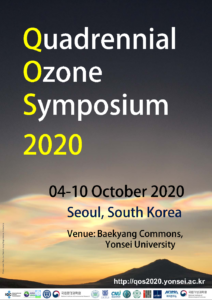A number of SPARC-related sessions have been organised for 2020 EGU General Assembly in Vienna, 3-8 may 2020 (abstract submission deadline: 15 January 2020). The following is a non-exhaustive list:
— Please let the SPARC Office know about missing SAPRC-related sessions int he following list! —
AS1.9 – Subseasonal-to-Seasonal Prediction: meteorology and impacts
Primary Convener: Frederic Vitart
Co-Conveners: Francesca Di Giuseppe, Daniela Domeisen, A.G. Muñoz, Christopher White
Session link: https://meetingorganizer.copernicus.org/EGU2020/session/36782
Submit Abstract to this session
AS1.17 – Asian Monsoon dynamics and Atmospheric Composition
Primary Convener: Federico Fierli
Co-Conveners: B. Adhikary, Silvia Bucci, Fred Stroh
Submit Abstract to this session
AS1.18 – Stratospheric Dynamics
Primary Convener: Thomas Reichler
Co-Conveners: Blanca AyarzagüenaECS, Bo Christiansen, Seok-Woo Son
Submit Abstract to this session
AS3.2 – Atmospheric composition variability and trends
Primary Convener: Oksana Tarasova
Co-Conveners: Pedro Jimenez-Guerrero, Euan Nisbet, Andrea Pozzer
Submit Abstract to this session
AS3.3 – Middle atmosphere composition and feedbacks in a changing climate
Primary Convener: Gabriel Chiodo
Co-Conveners: William Ball, Mohamadou Diallo
Submit Abstract to this session
AS3.5 – Dynamics and chemistry of the upper troposphere and stratosphere
Primary Convener: Daniel Kunkel
Co-Conveners: Marta Abalos, Thomas Birner, Harald Boenisch, Felix Ploeger
Submit Abstract to this session
AS3.24 – Dynamics and chemistry of the upper troposphere and stratosphere
Primary Convener: Farahnaz Khosrawi
Co-Conveners: Hideaki Nakajima, Michael Pitts, Ines Tritscher
Submit Abstract to this session
AS4.29/ITS2.13 – Characterizing, understanding, predicting the radiative effects of major volcanic eruptions and their impacts on climate and societies
Primary Convener: Myriam Khodri
Co-Conveners: Claudia Timmreck, Davide Zanchettin, Graham Mann, Matthew Toohey
Submit Abstract to this session
CL4.11 – Dynamics of the atmospheric circulation in past, present and future climates
Primary Convener: Michael Byrne
Co-Conveners: Thomas Birner, Nicholas Lutsko, Max Popp, Talia Tamarin
Session link: https://meetingorganizer.copernicus.org/EGU2020/session/36770
Submit Abstract to this session
OS4.3 – Internal Gravity Waves
Primary Convener: Alvaro de la Camara
Co-Conveners: Ulrich Achatz, Riwal Plougonven, Chantal Staquet, Claudia Stephan
Submit Abstract to this session

